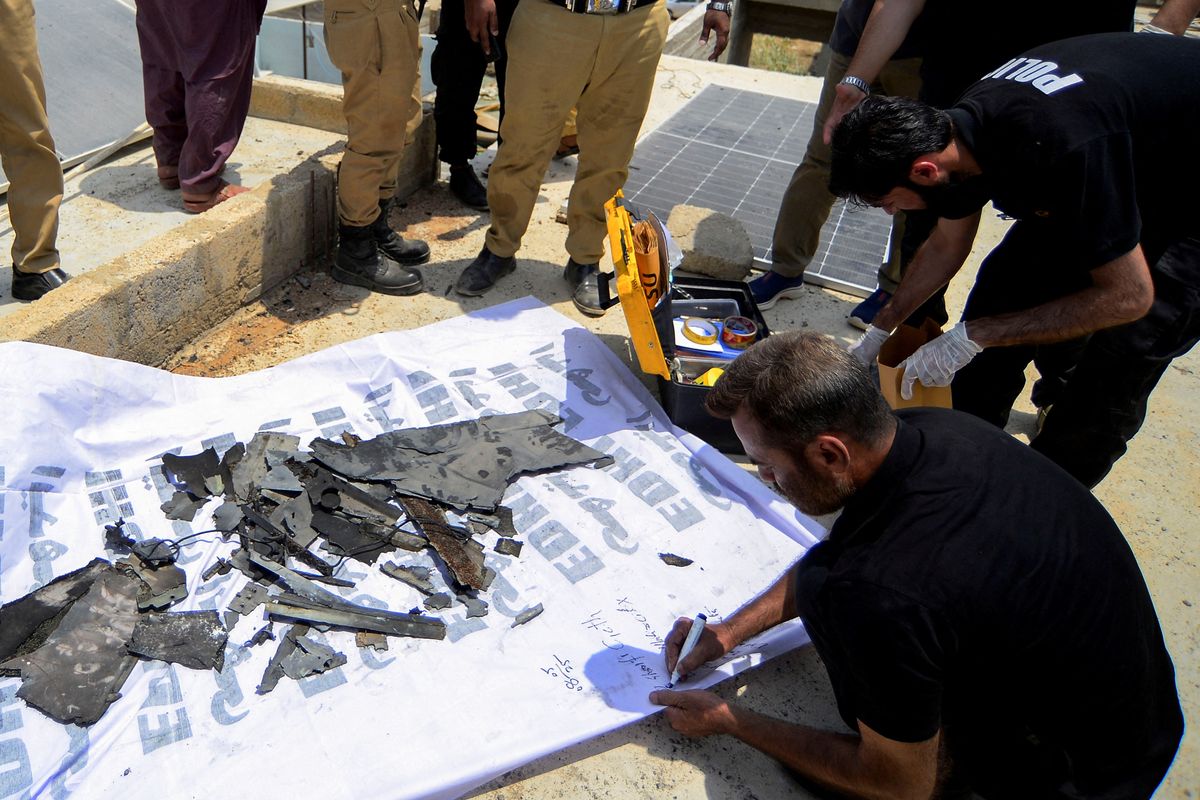Drone swarm over Sindh raises alarm in Pakistan
Flights over strategic military and industrial sites were a message, Pakistani analysts say

A member of the Crime Scene Unit (CSU), inspects the fragments, of what they say is a drone, after it was brought down on the outskirts of Karachi, Pakistan May 8, 2025.
Reuters
When a swarm of drones from India entered deep into southern Pakistan, it sparked alarm and speculation—not just over regional tensions, but over broader geopolitical alignments. The drones were spotted over three key sites in Sindh province: Chhor, Ghotki, and Karachi —all of which carry major strategic, economic, or military importance.
Malir (Karachi)
In southern Karachi, Malir borders critical military facilities, including airbases and cantonments, and lies near Jinnah International Airport. It’s a high-security zone during times of regional tension.
Chhor
Located in the Thar Desert near the India-Pakistan border, Chhor houses a major Pakistan Army base and the Desert Warfare School.
The area has historical significance from the 1965 and 1971 wars.
Its terrain and proximity to India make it a prime location for training in desert combat scenarios.
Ghotki
The industrial town of Daharki in Ghotki district stands out for its high-value infrastructure.
The region houses some of the country’s largest fertilizer and energy plants, many operating under or in close coordination with military oversight.
The region is strategically placed along the National Highway and is closely tied to both commercial and military logistics.
Attack or surveillance?
According to defense analysts, drones like those used in this operation are increasingly being deployed for strategic surveillance rather than direct attacks.
None reportedly carried explosives, indicating their likely role was intelligence gathering and reconnaissance.
“It’s a statement: We’re watching, and we can get this close,” said one analyst who did not wish to be named.
Some analysts said the use of drones in this manner pushes the boundaries of acceptable surveillance and the real threat lies in the deliberate breach of Pakistani airspace.
Civilian death raises concern
In Daharki, a drone crashed into a field, killing 35-year-old Mukhtiar Ahmed Leghari.
Indian media outlets alleged links between Leghari and militant groups, but local journalists and residents refuted the claim, confirming he was a farmer simply working his land when the drone went down.
His death has sparked serious concerns. If the drones were not intended for attack, why were they flying so low over civilian areas?
The drone incident has intensified tensions between India and Pakistan, with Islamabad accusing New Delhi of conducting aerial missions to expose its defense positions—a claim India links to an alleged prior attack it blames on Pakistan.
Defence Minister Khawaja Asif told Parliament that the drones were deliberately not intercepted to prevent the disclosure of sensitive air defense locations.
Brigadier (retd) Rashid Wali Janjua warned of a proportionate response, stressing the danger of missteps between two nuclear-armed neighbors.
As diplomatic channels remain active, Asif noted Pakistan is in constant contact with regional allies to contain the crisis.










Comments
See what people are discussing